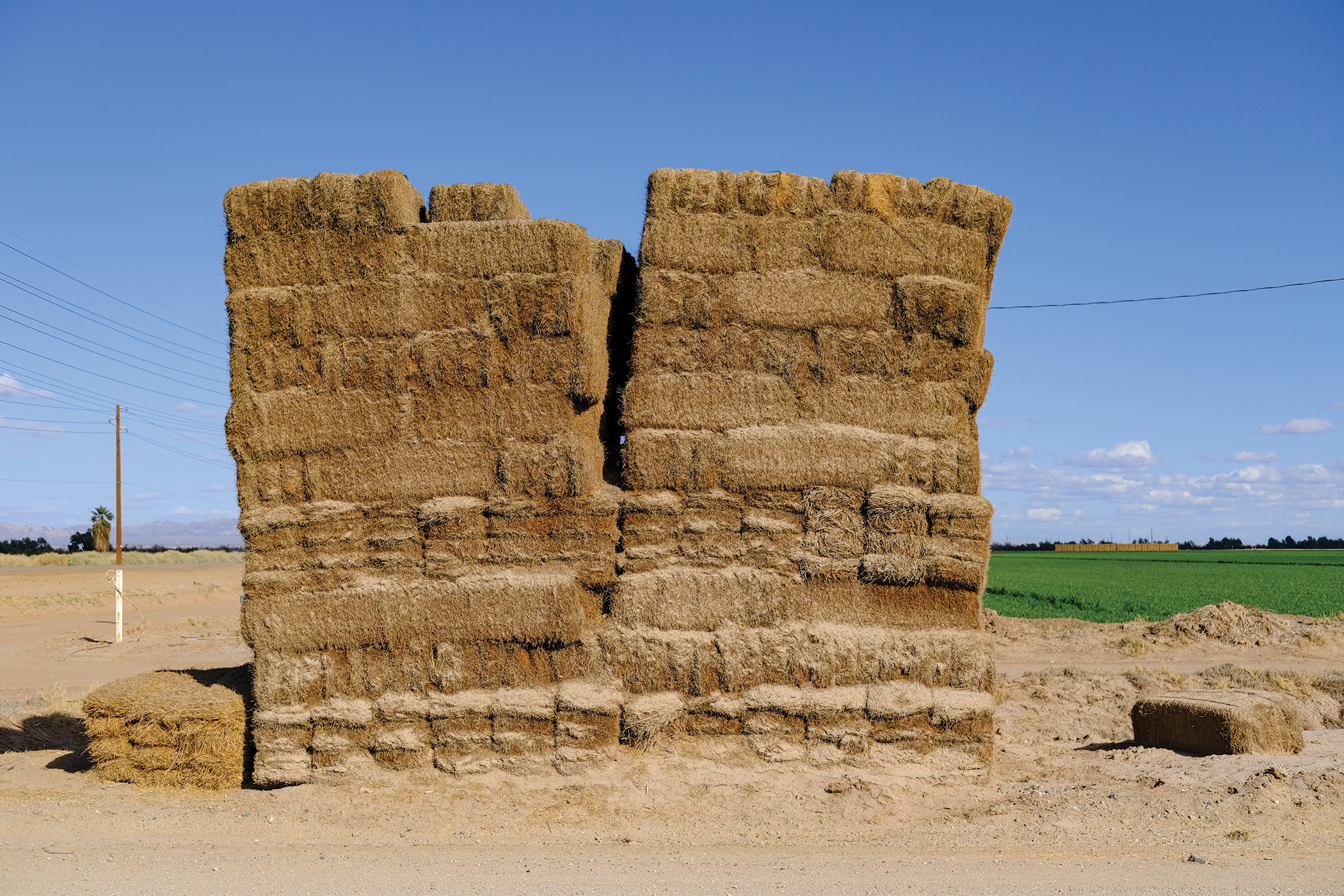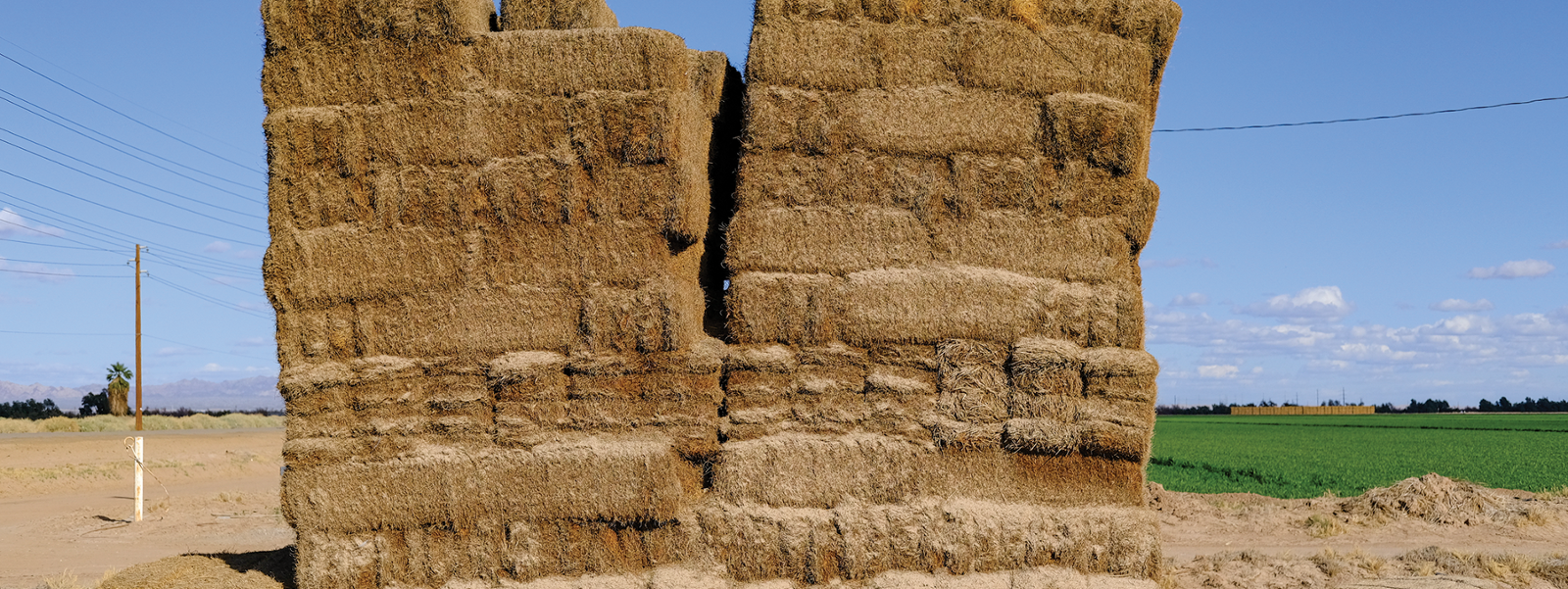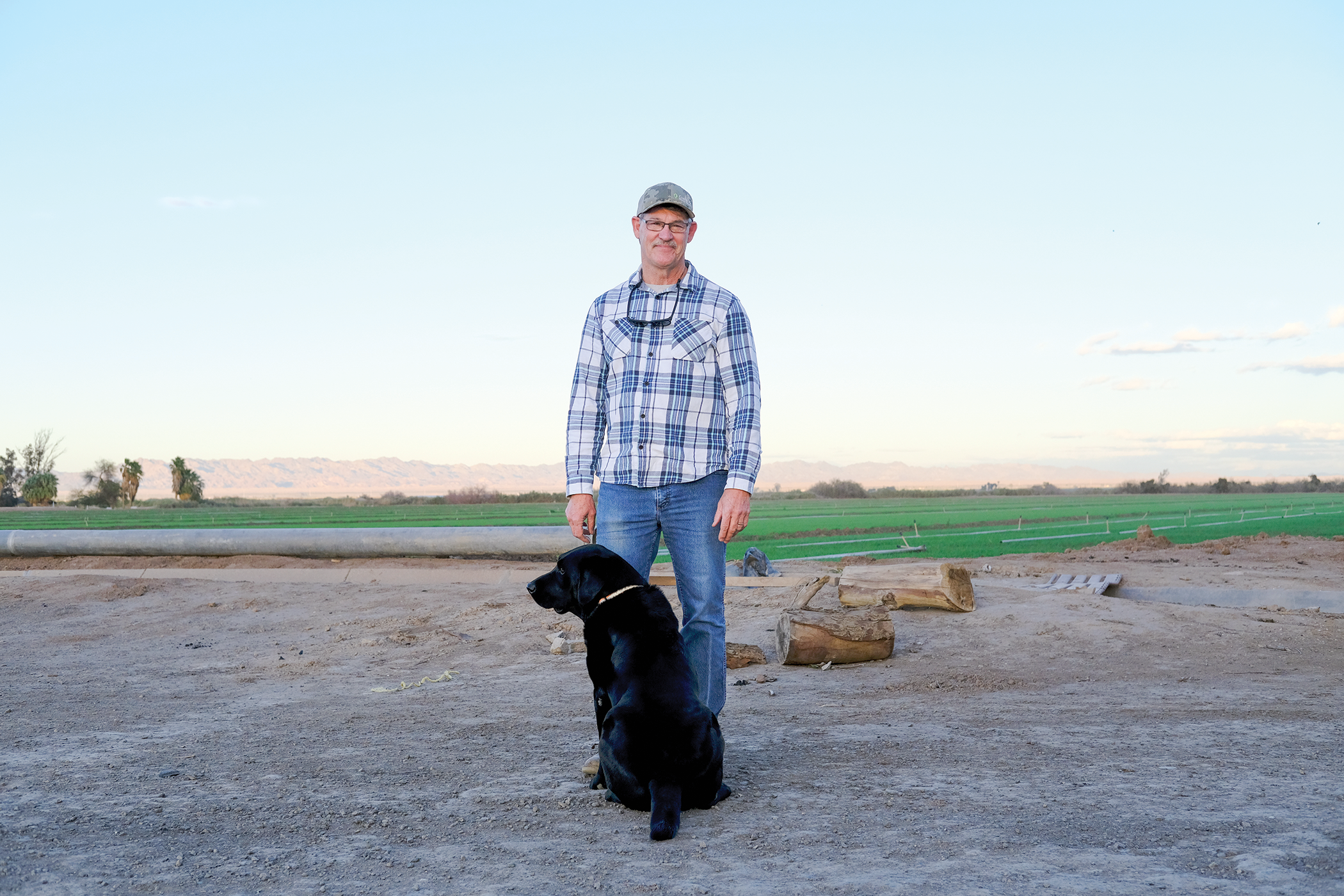Desert farmers defend maligned alfalfa production


Bales of alfalfa hay sit under the sun by an Imperial Valley roadside near Calipatria. The high-protein forage crop covers roughly a third of the valley’s farmland and is harvested in the region year-round.

By Caleb Hampton
The Imperial Valley, a vast grid of greens, browns and yellows, produces dozens of crops. But two visual features define the valley: open channels carrying water from the Colorado River and blocks of hay that tower above the irrigation channels.
Forage crops such as alfalfa, sudangrass and bermudagrass cover more than half the Imperial Valley’s farmland. “From the growers’ perspective, alfalfa is their best crop,” said Ali Montazar, University of California Cooperative Extension irrigation and water management advisor for Imperial, Riverside and San Diego counties.
But as the Colorado River dwindles, environmentalists and competing water users scorn farmers for growing the thirsty crop in a drought-stricken region. “It’s simple math,” High Country News reported last year. “Growing less hay is the only way to keep the river’s water system from collapsing.”
Much of the criticism of California’s alfalfa production focuses on the crop’s export to countries such as China, Japan and Saudi Arabia. In recent years, California has exported around 30% of its hay, with several estimates showing a higher proportion from the Imperial Valley is sold abroad. Some critics liken it to shipping “virtual water” out of a drought zone and overseas.
It is true that alfalfa needs lots of water—more than almost any crop in California. However, growers say criticism of its cultivation in the desert region overlooks important context around the nuances of crop planning, the globalized food system and alfalfa’s role in nutrition and food security. The crop is also a key contributor to the Imperial Valley’s economy.
The region’s geography is ideal for alfalfa production. Because the Imperial Valley gets year-round sun, farmers can harvest alfalfa up to 10 times per year, yielding twice as much hay as many other growing regions. “We probably have the highest yield and highest quality alfalfa in the world,” said Larry Cox, who farms in the Imperial Valley.
Other factors, such as the crop’s tolerance of the Colorado River’s high-saline water, the ability to store hay in the open without fear of weather damage and proximity to dairies and cattle ranches that purchase it, are additional benefits. “Nowhere can compete with here,” said Montazar, who is based in Holtville and has researched alfalfa for more than a decade.
Harvested year-round, alfalfa serves as a reliable cash crop for Imperial Valley farmers while they rotate various specialty crops, including most of the nation’s winter vegetables. “It’s very helpful for them,” Montazar said. If the region’s base crop were taken away, researchers say, the fragile balance that makes the farms financially viable could collapse, jeopardizing not only alfalfa production but everything else.
To operate as a sustainable business, each farm must consider factors such as supply and demand, soil health, labor needs, water use and input costs when choosing what to plant. Ultimately, the acreage is a mirror of consumers’ needs and desires, with each commodity planted proportionate to demand.
Imperial Valley farmer Andrew Leimgruber mused that he would swap alfalfa out for quinoa if people preferred it to pizza, hamburgers and ice cream. “We only grow what consumers want to eat,” he said. For now, alfalfa—essential to dairy and beef products—has seen growing demand, with prices at an all-time high.
“Agriculture is all of us,” said Chris Scheuring, senior counsel for the California Farm Bureau, who farms in Yolo County. “There’s a disconnect between the way people behave in the grocery store and the way certain people talk about farming in general and alfalfa in particular.”
Naturally high in protein, alfalfa is a choice feed for dairy cows. Dairies convert it into high-protein foods such as milk, cheese and baby formula, which are consumed around the world. In the U.S., these products play an important part in food assistance programs, such as the Special Supplemental Nutrition Program for Women, Infants and Children, or WIC, which serves millions of people each year including nearly half of all infants.
“It’s not like it’s being fed to animals and then it’s just gone,” said Imperial Valley farmer Mark Osterkamp.
Globally, California’s sizable presence in the alfalfa market is driven by a fluke in international trade patterns as container ships bringing goods and materials from Asia offer cheap rates to pick up hay rather than return empty across the Pacific.
Growers and farm advocates argue that blaming virtual water exports on alfalfa is a narrow and arbitrary view of a much bigger picture. Despite drought concerns, studies have found that California actually imports more virtual water than it exports. When it comes to agricultural products, several commodities account for more water used for export than alfalfa.
“We’re an urbanized, consumptive state of 40 million people,” Scheuring said. “If you were to calculate how much water is imported into California through all the manufacturing processes associated with mining, manufacturing and bending steel, all the way up to creating a beautiful new Prius, that’s a lot of water.”
Researchers also raise another question. “If we eliminate alfalfa here,” Montazar asked, “where do we take it?”
Over the past two decades, alfalfa acreage in other parts of California has declined, largely due to water challenges throughout the state. Worldwide, Spain, the second-largest producer, is in the midst of its own severe drought. “It needs to be grown somewhere,” Montazar said, “because there is a need for it.”
Farmers in the Imperial Valley argue they can grow alfalfa better than anywhere else, not only in terms of yield and quality but also with respect to the environment. “Other countries do not have regulatory structures protecting species, water quality and labor standards in the same way that California does,” Scheuring said. “We need to have a lot of alfalfa somewhere. And if we care at all about those things—the environment and labor impacts—we should be farming here.”
That doesn’t mean it will be easy. For the past two decades, Imperial Valley farmers have shipped up to 18% of their water supply each year to cities in Southern California. Now, as part of California’s plan to address the Colorado River crisis, they are set to forfeit additional supplies.
Continuing to farm in the Imperial Valley may mean phasing in crops that use less water or fallowing some alfalfa fields. It will also require farmers to become more water efficient when growing alfalfa. Farmers have already responded in each of these ways. But for the most part, they are sticking with alfalfa—its acreage in the region increased last year—and are investing in the infrastructure to conserve water while growing it.
Since 2003, the farmers, with funding from the Imperial Irrigation District, have invested half a billion dollars to install water-conservation infrastructure such as drip irrigation, sprinklers, precision-leveling and tailwater return systems, which enable them to save water when irrigating alfalfa and other crops. Last year, the federal government approved $4 billion in funding to address the Colorado River crisis, some of which could be used to expand the Imperial Valley’s water-efficient irrigation systems.
“We need to listen to the growers,” Montazar said. “The solution is not to eliminate alfalfa. The solution is to help them grow it more efficiently.”
By cultivating alfalfa in the Imperial Valley, the growers say, they are maintaining an important link in global nutrition and protecting the valley’s economy.
“We firmly believe that we’ll use technology and economics to save as much water as we possibly can,” Osterkamp said. “And we’ll continue to grow the same crops and employ the same number of people.”
(Caleb Hampton is an assistant editor of Ag Alert. He may be contacted at champton@cfbf.com.)
Read the series:
Part 1
Colorado River crisis tests a proud region
Facing cuts, farmers step up on water conservation
Part 2
Desert farmers defend maligned alfalfa production
Part 3




